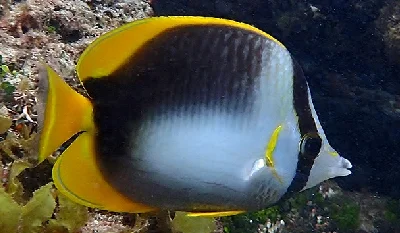Somali Butterflyfish
Chaetodon leucopleura
Chaetodon leucopleura, commonly referred to as the Somali butterflyfish, represents a species within the marine ray-finned fish category and is part of the Chaetodontidae family. This species primarily inhabits the northwestern region of the 🌊 Indian Ocean.
Characterized by a laterally compressed, oval-shaped body with a pointed snout typical of butterflyfish, Chaetodon leucopleura exhibits distinctive coloration. The lower portion of its body is white, transitioning to a dark grayish-black on the upper half. Notably, a yellow curved line is present along the edge of the operculum, and a black bar traverses the eye area. Additionally, 5 to 6 thin, horizontal lines extend between the eyes, while the upper lips are black. The fins of Chaetodon leucopleura are yellow, with the dorsal fin comprising 12 spines and 21 to 23 soft rays, and the anal fin featuring 3 spines and 18 to 19 soft rays. This species reaches a maximum standard length of 18 centimeters (7.1 inches).
Geographically, Chaetodon leucopleura is distributed along the East African coast from 🇸🇩 Sudan to Zanzibar, including the Socotra (🇾🇪 Yemen) archipelago, the 🇸🇨 Seychelles, and extending south to Aldabra (🇸🇨 Seychelles). In the southern 🌊 Red Sea, it is found around the Farasan Islands of 🇸🇦 Saudi Arabia and off the coast of 🇾🇪 Yemen.
Preferring deeper waters, Chaetodon leucopleura is typically found at depths ranging from 7 to 80 meters (23 to 262 feet). Its habitat includes coral-rich reefs, often near the bases of slopes over coral scree, and it is usually observed either solitarily or in pairs over open seafloors. Despite being an uncommon species, Chaetodon leucopleura forms pairs for breeding and is oviparous. Its diet predominantly consists of coral polyps and benthic invertebrates.
The species was first formally described in 1867 by Scottish naturalist Lambert Playfair (1828–1899), with its type locality identified as Zanzibar. Chaetodon leucopleura is tentatively classified within the extensive subgenus Rabdophorus, which may warrant recognition as a distinct genus in the future.
Comments
Please, sign in to leave comment
No Comments yet
Last Update: May 28, 2025

